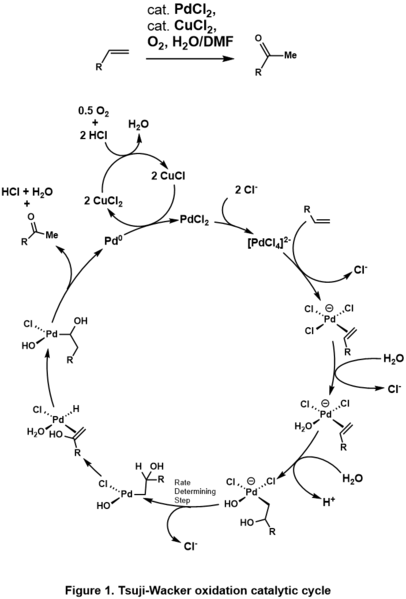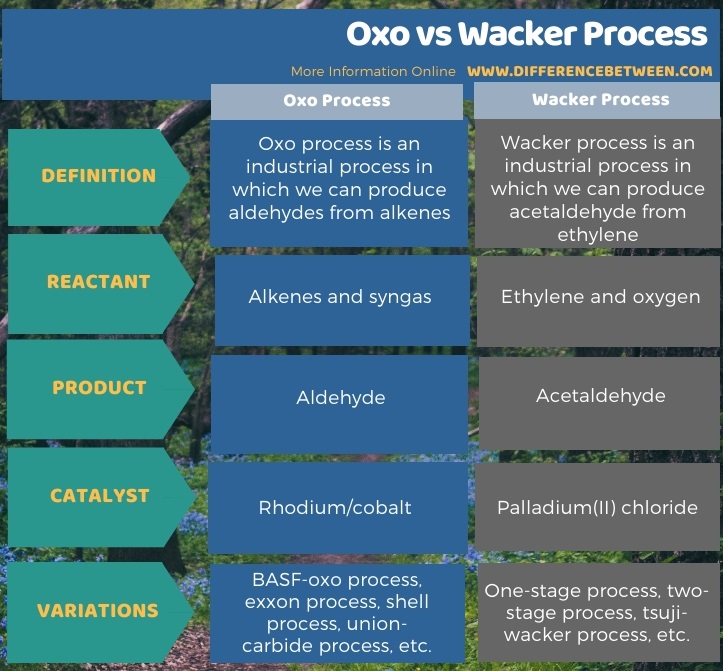Difference Between Oxo and Wacker Process
The key difference between oxo and wacker process is that the oxo process is a technique to produce aldehydes from alkenes, whereas the wacker process is a technique to produce acetaldehyde from ethylene.
Both oxo and wacker processes are used for aldehydes; oxo process produces aldehydes while wacker process modifies aldehydes. Both of these processes are very important in industrial-scale applications. Moreover, both oxo and wacker processes require catalysts for their initiation and progression.
CONTENTS
1. Overview and Key Difference
2. What is Oxo Process
3. What is Wacker Process
4. Side by Side Comparison – Oxo vs Wacker Process in Tabular Form
5. Summary
What is Oxo Process?
Oxo process is an industrial process in which we can produce aldehydes from alkenes. Sometimes, we call it hydroformylation. It is a type of addition reaction since it involves the addition of a formyl group to the C=C group of the alkene. Here, one carbon atom of this double bond is added with a formyl group (-CHO) and the other carbon atom is added with a hydrogen atom. The resulting aldehydes can be converted into many different secondary products, such as conversion into alcohols and other chemicals. Therefore, this production process is very important.

Figure 01: General Formula for Oxo Process
A major consideration regarding the oxo process is selectivity. We can observe the “normal” vs “iso“ selectivity. It is because the hydroformylation of alkenes can give two isomeric products: the normal aldehyde and the iso-aldehyde. Usually, the normal linear form is more desirable. Besides, the steric effects and electronic effects are also important in the production process because these effects determine the final output.
There are variations of the oxo process. For example, BASF-oxo process, Exxon process, shell process, union-carbide process, etc. Moreover, we can use some reactants other than alkenes along with specific catalysts. For example, formaldehyde and ethylene oxide can be used as reactants in the presence of cobalt carbonyl and rhodium complexes as catalysts, respectively. These reactions give a higher yield at basic environments.
What is Wacker Process?
Wacker process is an industrial process in which we can produce acetaldehyde from ethylene. Here, the process involves the oxidation of ethylene. The reaction progresses in the presence of palladium(II) chloride catalyst. It is a homogeneous catalysis reaction.

Figure 02: Process Summary for Wacker Process
The major reaction in this process is as follows:
[PdCl4]2- + C2H4 + H2O ⟶ CH3CHO + Pd + 2HCl + 2Cl–
After that, a few more reactions occur in order to regenerate the catalyst palladium(II) chloride. Therefore, in this process, only oxygen and the alkene are consumed as the reactants. However, there are some variations in the wacker process, such as one-stage process, two-stage process, Tsuji-wacker process, etc.
What is the Difference Between Oxo and Wacker Process?
Oxo and wacker processes are important industrial processes. The key difference between oxo and wacker process is that the oxo process is a technique to produce aldehydes from alkenes. Meantime, the wacker process is a technique to produce acetaldehyde from ethylene. Therefore, the oxo process involves the formation of aldehyde, whereas the wacker process involves the formation of a modified aldehyde; acetaldehyde.
Furthermore, the catalyst of the oxo process is a homogeneous rhodium/cobalt catalyst, while the catalyst of the wacker process is palladium(II) chloride. Also, another difference between oxo and wacker process is that the reactants for the oxo process are alkenes and syngas, while the reactants for the wacker process are ethylene and oxygen.

Summary – Oxo vs Wacker Process
In summary, the oxo and wacker processes are important industrial processes. The key difference between oxo and wacker process is that the oxo process is a technique to produce aldehydes from alkenes, whereas the wacker process is a technique to produce acetaldehyde from ethylene.
Reference:
1. “Wacker Process.” Wikipedia, Wikimedia Foundation, 12 Dec. 2019, Available here.
2. “Hydroformylation.” Wikipedia, Wikimedia Foundation, 30 Dec. 2019, Available here.
Image Courtesy:
1. “Hydroformylation V.2 en” – (CC0) via Commons Wikimedia
2. “TW Cycle” By Berkeleyone – Own work (CC BY-SA 4.0) via Commons Wikimedia
ncG1vNJzZmivp6x7pbXFn5yrnZ6YsqOx07CcnqZemLyue8OinZ%2Bdopq7pLGMm5ytr5Wau26716hkmqaUYsSir8qeqWaooqSwpr%2FSaA%3D%3D